Translations 677
Ukraine: the war that must end

Ukraine: the war that must end
It is not a matter of mere assessments to blame the U.S. Government for what is currently happening in Ukraine, but there are statements that very lightly limit themselves to “it was Russia who attacked Ukraine”.
Translated and edited by Walter Lippmann for CubaNews.
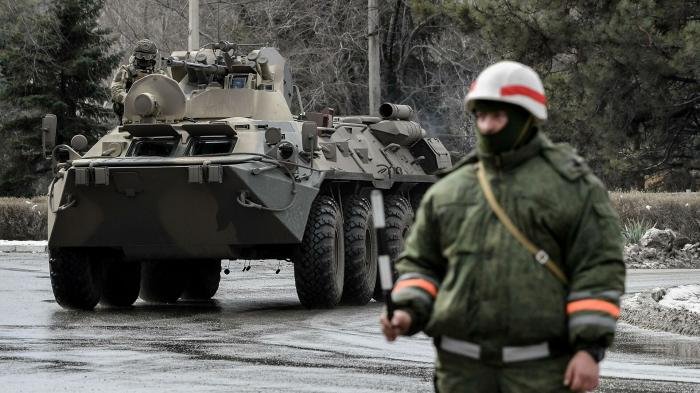
Photo: Sputnik
These are not mere assessments to blame the US government for what is currently happening in Ukraine, but there are statements that very lightly limit themselves to “it was Russia who attacked Ukraine”.
It is necessary to go to safe sources, committed to peace, and go back to the history of U.S. wars, aggressions, bombings and other actions in the international arena.
Zhao Lijian, spokesperson for the Chinese Foreign Ministry, warned: “We must never forget who is the real threat to the world”. And he explained: “of the 248 armed conflicts that took place between 1945 and 2001 in 153 regions of the world, 201 were initiated by the US, accounting for 81% of the total”.
I don’t think anyone can be in any doubt as to who is really responsible for what is happening in Ukraine today. Washington’s destabilizing attempts to impose its hegemony are directed towards Russia.
Now, this justification –in the current case– has the ingredient that the Yankee power itself has made the European Union as an entity, as well as several of its main leaders, into spokespersons in favor of what the empire says and does.
What sense does it make for a continent -the European continent-, fiercely punished by two world wars that left millions of its children dead, wounded and mutilated, and entire cities destroyed, to ally itself again with those who were the first and only ones in the world to use the nuclear bomb, or who more recently and without consulting anyone, bombed Yugoslavia, a nation of that region?
Why not devote all the political forces in Europe to demanding withdrawal of all U.S. nuclear weapons, or the dozens of military bases installed on its territory and its hundreds of thousands of soldiers?
What other country in the world has an endorsement as questioned as that of the United States? What other power has hundreds of military bases scattered around the globe?
There was not supposed to be war in Ukraine, but unfortunately, there is. Therefore, all the strength and resources of the world should be directed to bringing the confrontation to an end as soon as possible. Let no more Ukrainians, Russians or other nationalities continue to die. Let only Russia and Ukraine seek the best way to live as neighbors: in peace and mutual respect.
A neutral Ukraine, where all its inhabitants, whether Russians or Ukrainians, live together in harmony and tranquility, united in the common desire to build an inclusive and prosperous country.
But militarizing Ukraine or encouraging it to join NATO is, above all, an historical irresponsibility with unpredictable consequences.
In this regard, the Russian Foreign Ministry has pointed out that financing Ukraine and supporting it militarily goes against the principles and agreements signed by the European Union.
It lists, among others, the fact that Kyiv ignores its obligations under the Minsk agreements, endorsed by UN Security Council Resolution 2202. Also the violation of human rights, with the use of weapons provided by the West for the ongoing repression in Donbas.
Russia warns about the risks of an escalation of the conflict due to the delivery of more weapons, which, in addition, threatens regional security and stability. It also points out the danger of deliveries of these war devices falling into the wrong hands, including those of terrorist organizations, given the uncontrolled distribution to the Ukrainian population.
Finally, Russia recalls that Ukraine’s economy is suffering as a result of the armed conflict.
How to Achieve Peace in Ukraine
 How to achieve Peace in Ukraine
How to achieve Peace in Ukraine
By Max Lesnik
March 01, 2022
Translated and edited by Walter Lippmann for CubaNews.
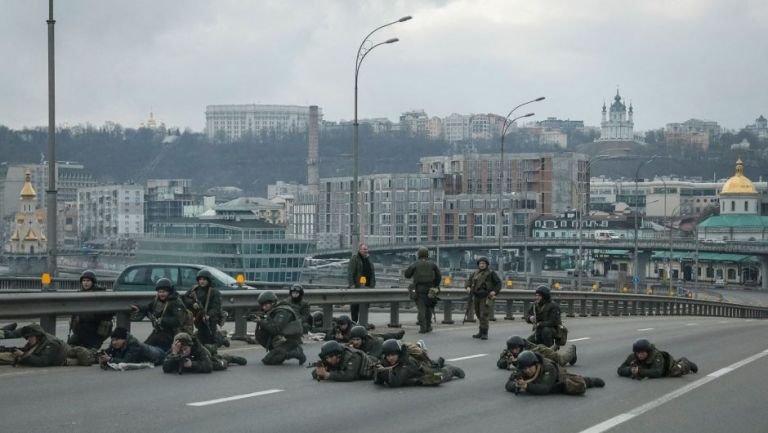
We can learn from history and thus avoid repeating past mistakes by seeking to replicate the successes only.
The crisis between Russia and Ukraine that has led to an open war between these neighboring countries, with the invasion of the territory of the latter by the former, leading to a very serious situation that could lead to a disastrous nuclear catastrophe for all mankind.
How was the so-called “October Crisis”, which almost led to a nuclear holocaust between the United States and the now defunct Soviet Union, resolved in 1962?
Diplomacy and not arms resolved the dangerous conflict that almost turned the “Cold War” into a “Hot War” that would have turned the world into a planetary cemetery at that time.
Cuba, already harassed by the United States since the triumph of its Revolution, was threatened by the “Colossus of the North” with invasion of its territory in Imperial response to the courageous attitude of the small Caribbean island that dared to defend its independence and sovereignty at whatever price was necessary.
It was then that another world power, the Soviet Union, rival of the United States in the so-called “Cold War”, in an attitude of solidarity and with the acquiescence of the revolutionary government, installed rocket batteries with atomic capacity on Cuban soil in order to respond militarily to the United States, in the event of an American invasion of the rebellious Cuba.
The world was on the brink of atomic war. But dialogue and diplomacy prevailed. An exchange of messages and letters ensued between Soviet Premier Nikita Khrushchev  and U.S. President John F. Kennedy, a dialogue that led to an honorable agreement between the conflicting parties .
The Soviets would withdraw the rockets which, according to Kennedy, because they were only a few miles from U.S. territory, threatened the security of his country. A solid and convincing argument.
In addition, Cuba would not be part of the so-called “Warsaw Pact”, a military alliance of the communist nations of Europe, equivalent to NATO, which unites militarily the United States with the nations of Western Europe.
In reciprocity, the United States would withdraw the atomic rockets they had in Turkey, which, because of their proximity to the territory of the Soviet Union, threatened the security of that nation. A solid argument that also convinces.
And most importantly. The United States accepted the commitment not to attack Cuba militarily. No invasion.
The so-called “Kennedy-Khrushchev Pact” saved the world from a nuclear holocaust.
In the current political-military crisis between Russia and Ukraine, the parties in conflict should seek a compromise to resolve their differences diplomatically, as was done during the October Crisis of 1962.
The Russians withdraw from Ukrainian territory and undertake not to invade neighboring Ukraine in the future. For its part, Ukraine renounces to be part of NATO and commits itself that in its territory, so close to Russia, atomic weapons that threaten Russian security will never be deployed. A solid argument that convinces.
This time Putin is in the role of Kennedy and Biden in that of Nikita Khrushchev.
I believe that Putin understands and would accept this commitment to world peace.
Will President Biden understand it as President Kennedy understood it then?
To be or not to be. That is the question!
Belafonte, the friend, on his 95th birthday

Belafonte, the friend, on his 95th birthday
When on July 23, 2020, Harry Belafonte held in his hands the Friendship Medal, awarded by the Cuban State, he surely edited in his memory, as in good movies, unforgettable sequences of the many moments of his life in which he shared luck, convictions and destiny with the inhabitants of the archipelago.
Translated and edited by Walter Lippmann for CubaNews.
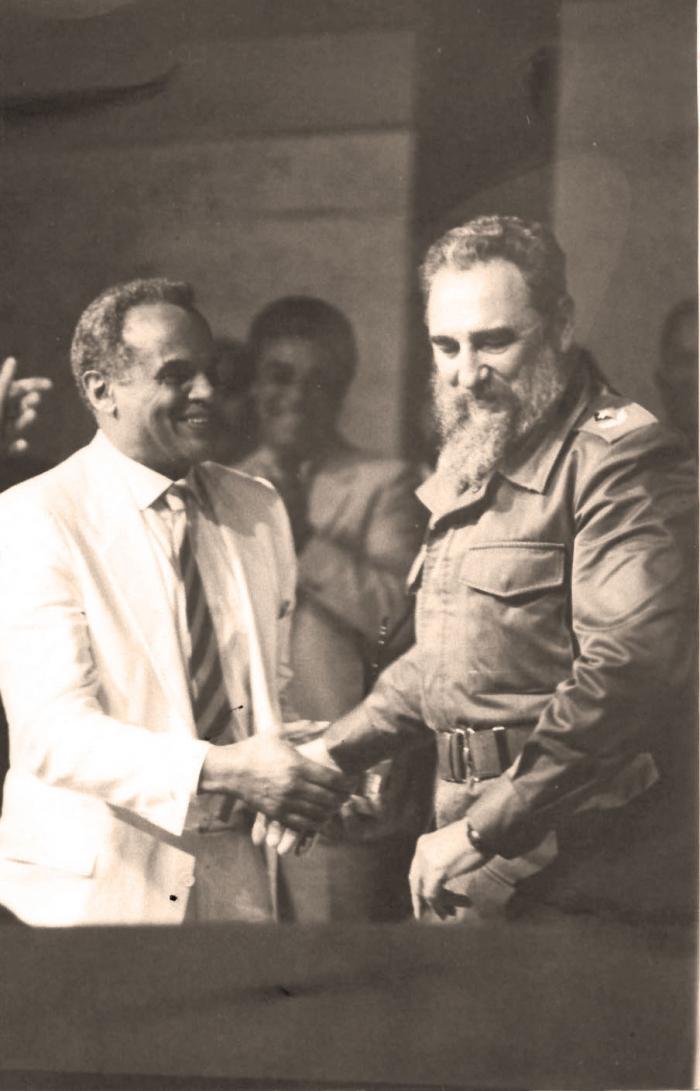
Fidel Castro and American actor and singer Harry Belafonte cultivated a very close relationship. Photo: Pedro Beruvides
When on July 23, 2020, Harry Belafonte held in his hands the Friendship Medal, awarded by the Cuban State, he surely edited in his memory, as in good movies, unforgettable sequences of the many moments of his life in which he shared luck, convictions and destiny with the inhabitants of the archipelago.
On that day, the then-Havana ambassador in Washington, José R. Cabañas, said: “This distinction is a recognition of his trajectory of solidarity with Cuba and his respect and admiration for the Cuban revolutionary process”.
On the 95th birthday of the American actor, musician and social activist – who was born on March 1, 1927, in New York – Belafonte continues to be a source of inspiration for many of his compatriots and for those of us who value the exceptional artist, the extraordinary human being and the dear friend.
One name cannot be missing in the consolidation of such a special bond: Fidel Castro. The historical leader of the Revolution and the actor and singer, Martin Luther King Jr.’s companion in the struggle, cultivated a very close relationship, since Belafonte met Cuba again in 1979, so as not to lose the route to Havana in the future, as long as his health allowed him to do so.
Harry got to know the city in the 19’50s, not without first crossing words and experiences with many Cubans living in New York, and feeling an affinity towards the music of the neighboring country, especially after listening to Chano Pozo with Dizzy Gillespie’s band.
In those same years, more than because of his films, the song Matilda penetrated the musical imagination of the Cubans of the time, a song that dates back at least to the 1930s, when the pioneer of calypso, the Trinidadian King Radio (really called Norman Span) released the song. Belafonte first recorded it in 1953 and it became an immediate hit, reinforced by its inclusion on his second full-length album with RCA Victor in 1955.
In his memoirs, My Song, published in 2011, still unpublished in Cuba in its Spanish version, he recounted: “When I became an artist and began to have some celebrity I went to Cuba quite regularly, before 1959. I went there with Sammy Davis Jr. and to listen to Nat King Cole, and to hang out with Frank Sinatra; the place where we hung out the most was the Hotel Nacional. Everybody was performing there except me. When they came to me – and I had a work contract, when the Habana Riviera Hotel first opened – I was in an interracial marriage as it was called in those days and suddenly I became persona non grata, in Cuba, everywhere.”
Right around that time he performed in Robert Rossen’s film, Island in the Sun, in which he played a black union leader from a fictitious West Indian territory who lived a love story with a young white woman from the upper-middle class (Joan Fontaine). The film generated controversy when it was released in the United States in mid-1957, because of what the racist elites considered its irresponsible transgression. After the triumph of January 1959, Fidel, who in addition to being an insatiable reader was a cinephile to the extent that his political and governmental responsibilities allowed, saw the film and talked about it to Belafonte, in front of his wife Julie and friend and colleague Sydney Poitier. For both Fidel and Harry, racism and discrimination based on skin color were inadmissible and abhorrent social and cultural manifestations.
In this regard, he observed in his memoirs: “Many Cuban exiles say that in Cuba there was no racism before the Revolution, that Cuba was never racist, never like the United States. I think that Cuba, among all the Caribbean islands, all with racist practices, was the most racist (…). So, when I went to Cuba after the Revolution, the first thing I noticed was the mixture of people, particularly among young people, there were still residues of the old customs, but certainly among the young people, when I went to the University, and when I went to the places of culture, when I went to the daycare centers, wherever I went in Cuba among the young people, I was deeply impacted by the fullness of racial integration. (…) I am not suggesting that in Cuba there is not some racism, but it is important to know that it is not an official state practice, nor is it institutionalized.”
It was precisely the objective and subjective factors that favored the reproduction of racist and discriminatory attitudes in Cuban life and the struggle for their eradication as an inalienable part of the Cuban revolutionary project, which occupied the dialogue between Fidel and Belafonte more than once. The American friend has received news of the implementation in the last two years of the National Program against Racism and Racial Discrimination, a work platform of obvious Fidelista inspiration.
One invaluable contribution of Harry Belafonte to the dismantling of prejudices had to do with the vindication of hip-hop culture, and particularly rap, in the Cuban scene. On one of his trips at the end of the last century, he met black rappers who told him how they found it difficult to get recognition from cultural institutions, so they offered their art in the underground scene.
Years later, interviewed by the American activist Sandra Levinson, he confessed: “I tell you something that impressed me a lot: I lived the hip-hop culture of Cuban rappers. (…) I was surprised by how many there were and how uninformed the hierarchy in Cuban cultural circles was of the whole hip-hop music culture. After meeting hip-hop artists in Havana, I met with Abel Prieto at a luncheon hosted by Fidel Castro, and we got to talking about hip-hop culture. When I returned to Havana a couple of years later, people from the hip-hop community came to see me and we hung out. They thanked me effusively and I said, why, and they responded, because your conversation with Fidel and the Minister of Culture about hip-hop led to there being a special agency within the Ministry. (…) What I think is important is how open the leadership was to this phenomenon called hip-hop, while in the United States we do a lot to demonize the culture, and we don’t even have a Ministry of Culture.”
As a testament to his unwavering solidarity and sense of justice, it is worth recalling the words with which he introduced the rally held at the Church of Reconciliation in New York on September 27, 2003. On that day he prayed for the Five Cuban anti-terrorist heroes undergoing long sentences in the United States. He also stated: “What is happening with our policy against Cuba is not the American way, it is not the true voice of the American people, it is not the true voice of those of us who believe deeply, profoundly, in the rights of all peoples, and the freedom of all people and in democracy. (…) There is a lot about the Cuban government, the Cuban people and what they have achieved, that many of us here are still trying to achieve.”
Why his support for the Cuban people? “I don’t see it as a supreme effort -he has said-, it is a way of life: if you believe in freedom, if you believe in justice, if you believe in democracy, if you believe in people’s rights, if you believe in the harmony of all humanity”.
Fidel is Fidel, as Estela Bravo reflected: “Fidel is Fidel. Unique for his time, his presence in the world improved the lives of millions of people”.
Island in the Sun (complete)
Reject sanctions policy against Russia

Reject sanctions policy against Russia
The governments of Cuba, Mexico and Venezuela expressed their opposition to the sanctions policies “in violation of international law” to which Russia has been subjected.
Translated and edited by Walter Lippmann for CubaNews.
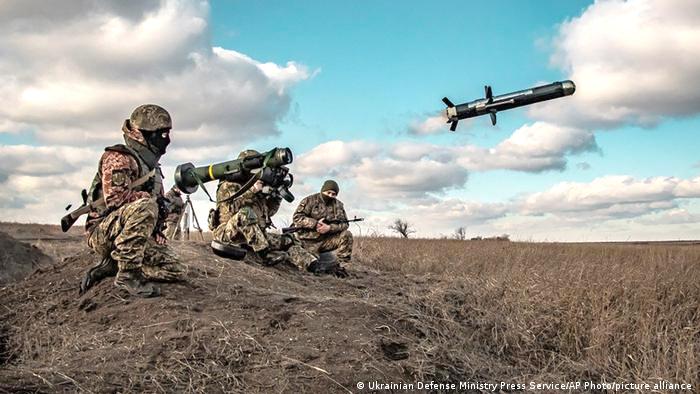
Russia urged the West to slow the flow of arms to Ukraine, to prevent more violent events. photo: AP
The governments of Cuba, Mexico and Venezuela expressed their opposition to the policies of sanctions “in violation of international law” to which Russia has been subjected after it decided to intervene in Ukrainian territory to preserve the security of its borders in the face of the expansion of the North Atlantic Organization (NATO).
Ambassador Pedro Luis Pedroso Cuesta, Cuba’s permanent representative to the United Nations, rejected the “hypocrisy and double standards” of the U.S. and NATO regarding Russia’s military operation in Ukraine and called for a careful assessment of the factors that led to the use of force.
In addition, the President of Mexico, Andres Manuel Lopez Obrador, declared, this Tuesday, during his morning speech to the media that, unlike the measures adopted by other states, his government will not impose any kind of sanctions on Russia after the military mission in Ukraine.
Likewise, the Venezuelan head of state, Nicolás Maduro, through a telephone conversation with his Russian counterpart, Vladimir Putin, expressed his support to the Eurasian country regarding the situation around Ukraine, while stressing the importance of counteracting the campaign of lies and disinformation carried out by the West.
During the sixth day of this conflict, the Ukrainian Foreign Minister, Dmitry Kuleba, assured that his country is receiving from abroad an “endless flow” of arms, ammunition and fuel.
On the contrary, the Russian Foreign Minister, Sergey Lavrov, urged the West to reduce the flow of arms in order to avoid more violent events, and rejected the proliferation of US nuclear weapons in Europe, reported Telesur.
At the same time, he warned about the possibilities of Kiev renouncing its non-nuclear status, which threatens security guarantees, both regionally and globally.
In view of this complex international scenario, also marked by a policy of economic sanctions against the Eurasian nation, the Russian government announced the imposition of provisional restrictions on the outflow of foreign investors’ assets, “to guarantee the financial stability” of the country, reported Russia Today (RT).
Extremely dangerous situation in Ukraine

Extremely dangerous situation in Ukraine
The territory of Ukraine is in an extremely dangerous situation, Kremlin spokesman Dmitry Peskov said, explaining that the army acts as terrorists because they install multiple rocket launchers in Kiev and Kharkov under the advice of foreign experts.
Translated and edited by Walter Lippmann for CubaNews.

Russian military presence in Ukraine. Photo: AP
The territory of Ukraine is in an extremely dangerous situation, Kremlin spokesman Dmitry Peskov called it, explaining that the military acts as terrorists because they install multiple rocket launchers in Kyiv and Kharkiv under the advice of foreign experts.
At this juncture, Vladimir Putin urged the Ukrainian military: “Do not allow neo-Nazis and ultra-nationalists to use your children, wives and old people as human shields, to take power into their hands. It seems that it will be easier to come to an agreement with you than with this gang of drug addicts and neo-Nazis who lodged in Kyiv and took the entire Ukrainian people hostage,” Russia Today quoted him as saying.
The head of state noted that the main fighting of the Russian Army is conducted, “not against regular units of the Armed Forces of Ukraine, but against nationalist formations, which, as is known, bear direct responsibility for the genocide in Donbass and the blood of civilian citizens of the people’s republics.”
He highlighted information that neo-Nazis are deploying heavy weapons in central areas of large cities, including Kyiv and Kharkiv, to provoke return fire from the Russian military against residential neighborhoods. “They act in the same way as terrorists all over the world: they hide behind people in the hope of blaming Russia for casualties among the civilian population,” Putin said.
Pope Francis visited the Russian Embassy to the Vatican to meet with the head of the diplomatic mission, Alexander Avdeev, to discuss the situation in Ukraine. The pontiff assured them that he is closely observing the development of events in Ukraine and expressed his concern about the escalation after the start of the military operation ordered on Thursday by Russian President Vladimir Putin.
Likewise, the presidents of Russia and China, Vladimir Putin and Xi Jinping, held a telephone conversation to discuss the Ukrainian crisis in a constructive and friendly atmosphere.
Xi stressed that he respects Russia’s actions in the crisis in the neighboring country and showed the coincidence of the positions of the two countries on the main issues of the international agenda, the Kremlin says in its statements.
Sanctions against Russia
The Council of Europe suspends Russia’s membership amid its military operation in Ukraine, a measure proposed by Poland and Ukraine that won the consensus of 42 of the committee’s 47 members.
Leaders of European Union countries agreed at an emergency summit to impose new economic sanctions against Moscow following the start of the military operation launched by Russia to defend Donbas.
European Commission President Ursula von der Leyen said that this second package of sanctions by the bloc will affect 70% of the banking market and Russia’s major state-owned enterprises, including those in the defense sector.
RT also highlighted the words of UK Foreign Secretary Liz Truss, who warned that London will continue to take action until the Russian economy is impaired and the integrity of Ukrainian territory is restored. “We will not rest until the Russian economy has been degraded and Ukraine’s sovereignty and territorial integrity have been restored,” the head of British diplomacy said.
Sputnik also noted the measures taken by Poland, which closed its airspace to Russian aircraft, while Switzerland banned financial transactions with 363 Russian individuals and four legal entities.
For his part, Russian Foreign Minister Sergei Lavrov accused NATO and the European Union of supporting Kiev in recent weeks, when it decided to seize by force the Donetsk People’s Republic and the Lugansk People’s Republic, in order to destroy the Minsk agreements. “The West fully supports the Kyiv regime in its efforts to sabotage and in the end destroy the Minsk Agreements,” Sputnik quoted Sputnik as saying.
However, no country in the transatlantic alliance wants to get involved in a war with Russia, according to statements by French Defense Minister Florence Parly and reminded that the Eurasian nation is a nuclear power.
MINREX: For international peace and security

Call for the preservation of international peace and security
Statement by the Ministry of Foreign Affairs
Author: MINREX | internet@granma.cu
Translated and edited by Walter Lippmann for CubaNews.
The United States’ endeavor to impose NATO’s progressive expansion towards the borders of the Russian Federation constitutes a threat to the national security of the Russian Federation and to regional and international peace.
The U.S. Government has for weeks been threatening Russia and manipulating the international community about the dangers of an “imminent massive invasion” of Ukraine. It has supplied weapons and military technology, deployed troops in several countries in the region, applied unilateral and unjust sanctions, and threatened other reprisals. At the same time, it has unleashed an anti-Russian propaganda campaign.
Cuba has previously warned about the danger of this policy.
On February 22, 2014, the then President of the Councils of State and Ministers, Army General Raul Castro Ruz, warned, “Right now, alarming events are taking place in Ukraine. The intervention of Western powers must cease (…). It should not be ignored that these events could have very serious consequences for international peace and security”.
Years later, on September 26, 2018, before the United Nations General Assembly, the President of the Republic, Miguel Díaz-Canel Bermúdez, warned that, “The continued expansion of NATO towards the borders with Russia causes serious dangers, aggravated by the imposition of arbitrary sanctions that we reject.
We call on the United States and NATO to seriously and realistically address the well-founded demands for security guarantees from the Russian Federation, which has the right to defend itself.
Cuba advocates a diplomatic solution through constructive and respectful dialogue.
We call for the preservation of international peace and security.
Ministry of Foreign Affairs of the Republic of Cuba
Havana, 22 February 2022
The Truth About Batista

The Truth About Batista
He was a pawn who implemented the policies for the region, advised by his mentors. His masters provided him with solid material support and military advice.
Translated and edited by Walter Lippmann for CubaNews.
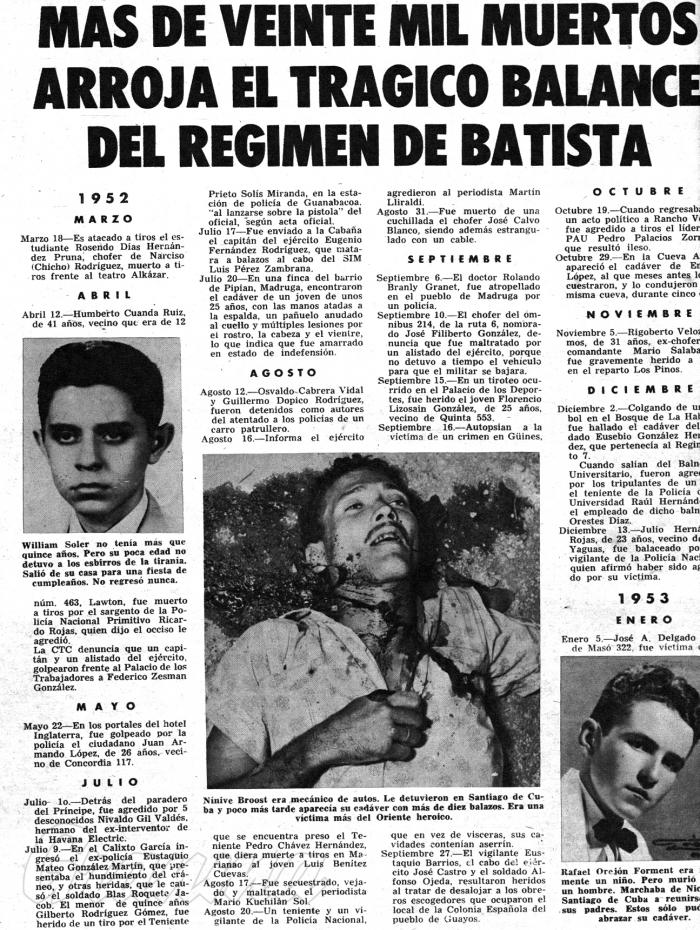
Page from Bohemia magazine, January 11, 1959 issue. Granma Archive
Lie, lie and lie some more. This is the line of the anti-Cuban media in South Florida, when dealing with the subject of the Island, in terms of current affairs, but also of the past.
For years, television networks, radio stations, websites and newspapers based there have, among their discursive guidelines -although the matrix has intensified notably during the last few weeks-, the vindication of the bloodthirsty tyrant Fulgencio Batista.
Throughout January and February 2022, there was a congestion of articles, comments and interviews with relatives of the dictator or alleged experts on his “legacy”. What has been said in such spaces about this terrifying character in Cuba’s history is so absurd and mendacious that it borders on delirium.
Any saint’s life would be dwarfed by such an avalanche of falsehoods aimed at ennobling the abject figure. But to really know who Fulgencio Batista was, it is not even necessary to go to “the history written by the communists”. The truth can even be found in the Western media, books and statements by high-ranking officials in Washington.
In 1952, this gentleman established the bloodiest and most corrupt dictatorship ever known in Cuba, with only the precedent of Gerardo Machado’s satrapy in terms of a criminal record.
Known for his previous work at the helm of the country, both because of his past as a coup leader and his pro-Washington fervors -demonstrated since his alliance with Ambassador Sumner Welles in 1933-, the 1952 uprising had the full backing of the U.S. Government.
He was a pawn who implemented the policies for the region, advised by his mentors. His masters gave him solid material backing and military advice, similar to what they did, years later, with the Pinochet misrule in Chile, after the coup against Salvador Allende.
U.S. investments would reach one billion dollars in Cuba throughout his term of office. The visits of then Vice President Richard Nixon and Allan Dulles, director of the CIA, in 1955, served to strengthen the empire’s economic and ideological programs on the island.
Dulles told the tyrant of his government’s concern about communist activity in Cuba, in response to which the dictator inaugurated, in a few weeks, the Bureau for the Repression of Communist Activities (the dreaded BRAC).
The “creature”, together with the no less dreadful Military Intelligence Service (SIM), the National Police and the Army, turned the country into a police state, in whose vortex people lived in permanent anxiety and where political disaffection was punished with death, without half measures.
Meanwhile, the U.S. mafia turned the night and gambling business into another empire in Cuba, called “the brothel of America”, a subject on which valuable research has been published.
Everyone in the north, bandits included, Batista had a free bar here. Thus, he sponsored the great assassins of Latin American history (Conrado Carratalá, Pilar García, the Salas Cañizares brothers -Rafael, Juan and José María- and Esteban Ventura Novo) and cohorts of criminals to defend his sinister political structure.
They were “men of base instincts, born criminals, beasts carrying all the ancestral atavisms dressed in human form”, to put it in Fidel’s words, who put the nation on edge and, especially, its youth, who died with their eyes gouged out, without nails, their testicles burst or raped, in barracks, ditches, wastelands, rivers, seas.
In his reign of “blood and plunder” -terms used by journalist Enrique de la Osa-, corruption surpassed all historical standards of a nation already expert in the matter. Batista, by himself, raised his presidential salary from 26,400 to 144,000 dollars, even higher than that of U.S. President Truman, whose salary was around 100,000 dollars.
However, a large part of the Cuban population was unemployed, while the majority of the peasants lived in huts with guano roofs [guano is the excrement of seabirds and bats] and dirt floors, with no sanitary services or running water. Meanwhile, 90% had no electricity.
As the French professor, Salim Lamrani states in his essay 50 truths about the Fulgencio Batista dictatorship in Cuba, the English economist Dudley Seers wrote that the situation in 1958 was intolerable: “in the countryside, social conditions were appalling. About a third of the nation lived in squalor (…) living in barracks, usually without electricity or latrines, victims of parasitic diseases and did not benefit from a health service.
“They were denied education (their children went to school for a year at the most). The situation of the precarious, installed in temporary shacks on collective lands, was particularly difficult (…). A significant proportion of the urban population was also very miserable”.
Arthur M. Schlesinger, Jr., personal advisor to President John F. Kennedy, wrote: “I loved Havana and was horrified by the way this lovely city was unfortunately transformed into a great casino and whorehouse for American businessmen (…). One wondered how Cubans – seeing this reality – could regard the U.S. in any other way than with hatred”.
This was the Cuba of misery, blood and terror imposed by Batista, the “beatific” president they now want to sell us from Florida. Just the thought of such a past redoubles our strength in the struggle to never go back to such a desolate scenario.
Ukraine and the spark of Donbass

Ukraine and the spark of Donbass
In a tweet, the member of the Political Bureau and Cuban Foreign Minister, Bruno Rodríguez Parrilla, wrote: “We strongly reject the propagandistic and communicational hysteria unleashed by the U.S. government against Russia and we firmly oppose the expansion of NATO to the borders of that brother country”.
Translated and edited by Walter Lippmann for CubaNews.
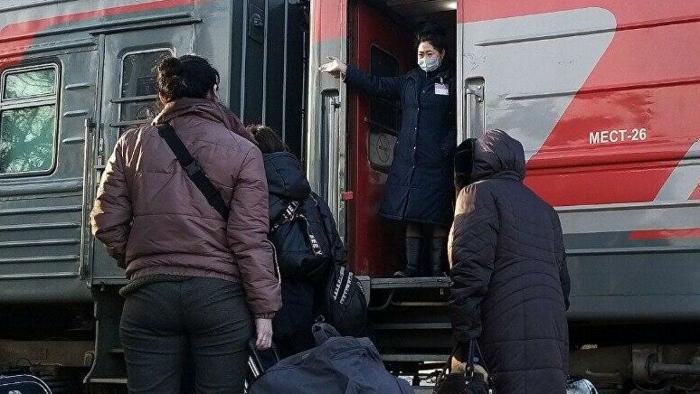
Russia estimates that more than 40 000 refugees from Donbas are already on its territory. Photo: Sputnik
The last week – that of the Russian “invasion” of Ukraine, fabricated by Washington – ended, and with it even the Russian military maneuvers, scheduled in advance, began the timeline for the return home of those involved.
Both the President of the United States, Joe Biden, as well as the highest exponents of NATO and some European rulers or subordinates were left wanting the shots to ring out and insisted on new lies on the same subject, but now more towards the inside of Ukraine than in the foreign environment.
The Kyiv government, used as “bait” for Russia to “take the bait” of the West and provoke a war, seems to be disappointed by so many lies and manipulation of those who have promised it NATO membership and the guarantee of its security in the face of a possible reaction from Moscow.
However, with these actions, the only thing they have caused Ukraine is a substantial economic loss that already exceeds $3 billion, without counting the bills that will be passed on later for the “aid” in weapons of all kinds that they are providing it with. But where are the shots and the supposed casualties caused by the Russian invasion? Where did the tanks and artillery that Washington announced would reach Kyiv come in.
Then they remembered a key piece in this puzzle: the separatist republics of Donbass with their territories of Donetsk (DPR) and Lugansk (LPR), in Ukraine, became, overnight, the spark of a new provocation against Moscow.
Kyiv, with its army, is staging a montage that cannot be sustained, but which already this weekend left some civilians dead and more than 40,000 people of Russian origin were forced to cross the border and take refuge in the Russian region of Rostov.
In view of the heated warlike mood, both Russia and Belarus, which had already ended their joint military maneuvers, have decided to prolong them. Belarusian Defense Minister Viktor Khrenin described the current scenario as “a strong smell of gunpowder” in the region, with the possibility of “Europe being pushed into a war”, as several neighboring countries are accumulating more advanced weapons, according to RT.
He also reiterated that the goal of the Russian and Belarusian maneuvers remains the same: “to ensure an adequate response and de-escalation of the enemies’ military preparations.”
In the meantime, the spark in Donbas may become, with the help of the West and the mainstream press at its service, a detonator that will make what Russia and the international community want to avoid – a war – a reality.
Carlos Lazo: I embraced Max Lesnik

Carlos Lazo: I embraced Max Lesnik knowing that he is a precursor of these #PuentesDeAmor.
I return to deliver my column to Carlos Lazo. Now with a more than deserved tribute to Max Lesnik, the legendary revolutionary of a thousand anecdotes who, from Cuba, in the United States and other corners of the world has written stories full of patriotism and humanism. Lazo, the president of Bridges of Love portrays him masterfully. HONOR TO WHOM HONOR IS DUE
By Carlos Rafael Dieguez
February 02, 2022
Photos by Michell Casanova
Translated and edited by Walter Lippmann for CubaNews.
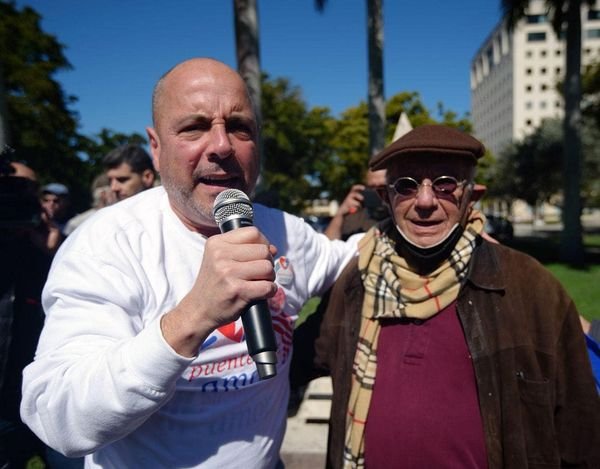 Max Lesnik is one of my heroes. A good Cuban, a good father, a good husband, a good friend. The other day I met him again in the Miami Caravan, raising his voice against the blockade. So old and yet so young, Max! I felt that his smile bore the accumulated joy of many decades, the same as when he was just a young boy and participated in the student struggles at the University of Havana against Batista’s tyranny.
Max Lesnik is one of my heroes. A good Cuban, a good father, a good husband, a good friend. The other day I met him again in the Miami Caravan, raising his voice against the blockade. So old and yet so young, Max! I felt that his smile bore the accumulated joy of many decades, the same as when he was just a young boy and participated in the student struggles at the University of Havana against Batista’s tyranny.
He hugged me and I felt again the great pride of sharing History, in capital letters and alive. In his eyes, I perceived the same stoicism, the same rebelliousness and transparency that he showed in 1960, when he left Cuba because he disagreed with the direction the Revolution was taking. Max has always been an honest man, without mincing his words.
Many years after that departure, his friend Fidel Castro would ask him, “Why did you leave?”. Max replied. “I didn’t like that Cuba was aligned with the Soviet Union.”
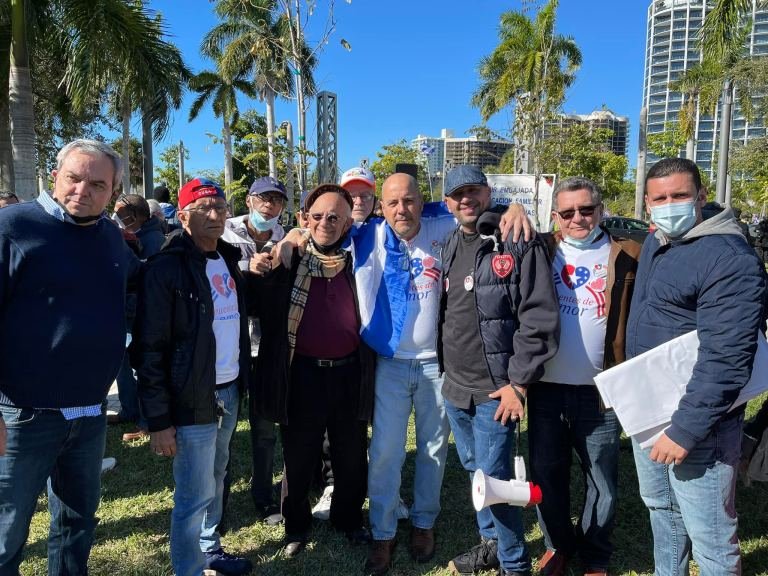 It is a privilege to be able to thank a man like him, a 90-year-old giant who is still in battle, coherent. The same Max who founded Réplica magazine in Miami. The “man of the two Havanas” -the “small” one in Miami and the big one on the island. The same Max who, in the United States, survived numerous terrorist attacks in an attempt to assassinate him, silence his message and overthrow his struggle. In him, always the same obsession: Cuba, Cuba, Cuba! Then and now.
It is a privilege to be able to thank a man like him, a 90-year-old giant who is still in battle, coherent. The same Max who founded Réplica magazine in Miami. The “man of the two Havanas” -the “small” one in Miami and the big one on the island. The same Max who, in the United States, survived numerous terrorist attacks in an attempt to assassinate him, silence his message and overthrow his struggle. In him, always the same obsession: Cuba, Cuba, Cuba! Then and now.
This Sunday I embraced the founder of the Alianza Martiana. Decades ago, in the United States, Max Lesnik and others founded that organization of diverse women and men. Since then, they dreamed of “a better relationship between the U.S. government and the peoples of Our America”. They opposed the blockade. In the Alianza, no one is rejected or discriminated against for reasons of creed, “race or political philosophy”. I embraced him knowing that he is a precursor of these #PuentesDeAmor through which we travel today and in which Max goes, ahead, removing weeds, opening possibilities, bringing Cubans together.
Max radiates that light carried by those who never stop fighting.
Carlos Lazo
February 2, 2022
Cuba: zero tolerance for drug trafficking

Cuba: zero tolerance for global drug trafficking threat
Permanent vigilance and timely response by specialized forces made it possible to dismantle a criminal network organized by Cubans from Mexico.
Translated and edited by Walter Lippmann for CubaNews.
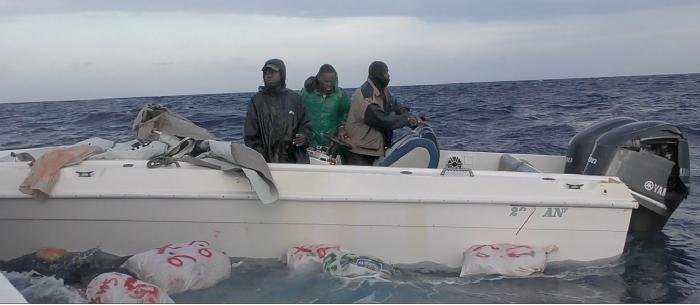
While the world is plunged into the devastating pandemic of COVID-19, hundreds of new and increasingly dangerous synthetic drugs are invading every corner of the planet, adding to the abuse of marijuana, cocaine and heroin, which affect almost 300 million people.
The main market on the planet, the United States, has the highest number of deaths from drug overdoses in its history, with more than 100,000 deaths between April 2020 and the same month in 2021, most of them due to the so-called opioid epidemic, which increased lethality by 28.5%.
Illicit drug trafficking and consumption continue to be a serious global phenomenon that threatens international security and from which no country can escape, due to the complex and sophisticated networks of the lucrative drug trafficking business (more than $600 billion in annual profits), the omnipresence of the mafias, the use of maritime and air corridors, ways of operating and inserting themselves into the dynamics of world trade, and allying with other forms of international organized crime.
The effects of international trafficking continued to impact Cuba in 2021, from the complex regional framework, its incidence in the Caribbean, the existence of routes close to our territory and the arrival of packages dragged by sea currents (recalos), which represented the largest volume of seized drugs and a potential danger for the articulation of internal trafficking. Attempts to smuggle or introduce drugs across maritime and air borders were also confronted; marijuana crops were dismantled and internal trafficking activities were neutralized.
The persistence and intentionality of Cuban and foreign emigrants to organize drug operations with the support of Cuban citizens was noted, for which they rearranged and diversified their actions, using unaccompanied loads, postal shipments and the use of speedboats.
One of the most dangerous trends of the year was the combination of human trafficking operations with attempts to smuggle drugs into the country using speedboats and other vessels, in line with the changes generated by international crime.
Likewise, 18 sightings of suspicious means that violated the airspace and eight vessels in alleged illicit operations were detected, all of which evidences an increase in the threats in the maritime and air environment of the Cuban archipelago.
These challenges demanded a redoubling of surveillance, persecution and coordinated confrontation between the bodies of the Ministry of the Interior (Minint), the General Customs of the Republic, other participating agencies and the people.
A YEAR OF INTENSE CONFRONTATION
According to information provided by MININT, as a result of the confrontation in 2021, Cuba seized a total of 4 162.23 kilograms (kg) of drugs, mostly marijuana; captured five naval means involved in drug trafficking operations and confiscated goods and sums of money due to these illicit activities.
The largest amount of drugs – it was revealed – was seized in the 295 drug seizures, higher than the 153 in 2020, and with a total of 2,338.64 kg of drugs seized in those events. Other high volumes were captured during the seizure of the aforementioned vessels.
As for the air border, 21 international drug trafficking operations were neutralized at the José Martí International Airport in the capital, in which 67.59 kg of these substances were seized and 41 people, including foreigners and nationals, were arrested.
In the fight against the cultivation of marijuana, 97 plantations were discovered, in which 32,868 plants and 48,521 seeds were seized. Meanwhile, 121 acts of internal trafficking were neutralized, with 165.63 kg of marijuana.
CHECKMATE AT SEA
The permanent surveillance and timely response of the specialized forces made it possible to dismantle a criminal network organized by Cubans from Mexico, with a support base in Panama, Costa Rica and Cuba, with the intention of smuggling marijuana, cocaine and methamphetamines, using passengers, cargo and speedboats in combined human and drug trafficking operations. As a result of this operation, 26 individuals were arrested, 303.37 kg of drugs were seized, and a speedboat was captured.
In addition, two other vessels linked to combined human and drug trafficking operations directed to Cuba from Mexico, the U.S. and Jamaica were neutralized and seized, in which significant amounts of marijuana and synthetic cannabinoids were seized.
In addition, two other speedboats were captured with six Bahamian crew members on board, who were seized with 1,291.82 kg of marijuana, and who were linked to operations not directed to Cuba.
The results of 2021 confirm the political will of the Cuban government to continuously strengthen the fight against the serious global scourge of drug trafficking and the prevention of drug abuse, and to prevent the use of airspace and territorial sea by international drug traffickers, with their lethal cargo destined for the main consumer markets, or to try to penetrate the country.
Subscribe to Blog via Email
| M | T | W | T | F | S | S |
|---|---|---|---|---|---|---|
| 1 | 2 | 3 | 4 | 5 | 6 | 7 |
| 8 | 9 | 10 | 11 | 12 | 13 | 14 |
| 15 | 16 | 17 | 18 | 19 | 20 | 21 |
| 22 | 23 | 24 | 25 | 26 | 27 | 28 |
| 29 | 30 | |||||
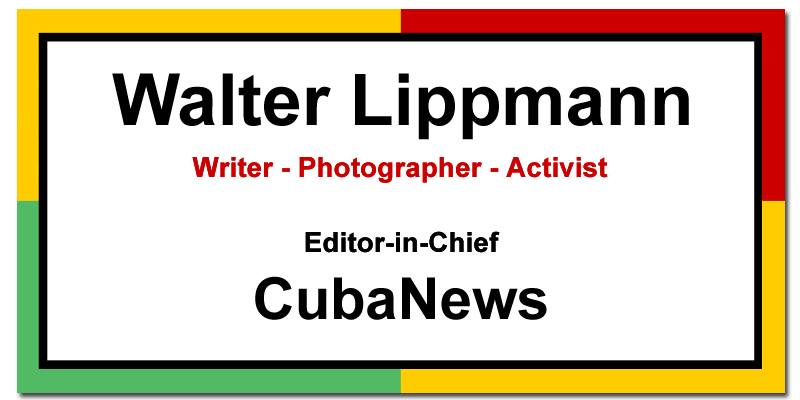
You must be logged in to post a comment.